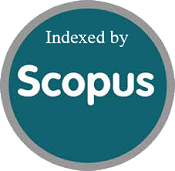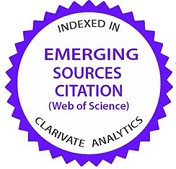Biosurfactant-enriched organic fertilizer as a sustainable strategy to reduce chemical inputs and improve maize performance on Ultisols
Abstract
Keywords
Full Text:
PDFReferences
Ariyanto, Y. N., Mubarokah, & Hendrarini, H. (2023). Analysis of Corn Supply In Indonesia. Journal of Economics, Finance and Management Studies, 6(7). https://doi.org/10.47191/jefms/v6-i7-45.
Aryanti, N., Heny, D. R., & Nafiunisa, A. (2020). Optimization of ultrasound-assisted extraction of rarak saponin from Sapindus rarak DC. using response surface methodology (RSM). AIP Conference Proceedings, 2197(1). https://doi.org/10.1063/1.5140912.
Aryanti, N., Nafiunisa, A., Kusworo, T. D., & Wardhani, D. H. (2021). Dye solubilization ability of plant derived surfactant from Sapindus rarak DC. extracted with the assistance of ultrasonic waves. Environmental Technology & Innovation, 22, 101450. https://doi.org/10.1016/j.eti.2021.101450.
Baquy, M. A.-A., Li, J.-Y., Jiang, J., Mehmood, K., Shi, R.-Y., & Xu, R.-K. (2018). Critical pH and exchangeable Al of four acidic soils derived from different parent materials for maize crops. Journal of Soils and Sediments, 18(4), 1490-1499. https://doi.org/10.1007/s11368-017-1887-x.
Bee, H., Khan, M. Y., & Sayyed, R. Z. (2019). Microbial Surfactants and Their Significance in Agriculture. In R. Z. Sayyed, M. S. Reddy, & S. Antonius (Eds.), Plant Growth Promoting Rhizobacteria (PGPR): Prospects for Sustainable Agriculture (pp. 205-215). Springer Singapore. https://doi.org/10.1007/978-981-13-6790-8_18
Berdjour, A., Dugje, I. Y., Rahman, N. A., Odoom, D. A., Kamara, A. Y., & Ajala, S. (2020). Direct estimation of maize leaf area index as influenced by organic and inorganic fertilizer rates in Guinea Savanna. Journal of agricultural science, 12(6), 66-75. https://doi.org/10.5539/jas.v12n6p66.
Bilyera, N., Zhang, X., Duddek, P., Fan, L., Banfield, C. C., Schlüter, S., . . . Razavi, B. S. (2021). Maize genotype-specific exudation strategies: An adaptive mechanism to increase microbial activity in the rhizosphere. Soil Biology and Biochemistry, 162, 108426. https://doi.org/10.1016/j.soilbio.2021.108426.
Bravin, M. (2018, 2018-07-08 / 2018-07-12). Revisiting the origins of root-induced pH changes in the rhizosphere [Paper without proceedings]. Symposium of the International Society of Root Research, Tel Aviv, Israël. https://events.eventact.com/ProgramView2/Agenda/Lecture?id=175855&code=3635645
de Oliveira, T. J. A., Dorner, S. H., & de Almeida, R. E. M. (2023). A Dependência do Agronegócio Brasileiro em Relação aos Fertilizantes Importados [The dependence of Brazilian agribusiness on imported fertilizers]. Informe Gepec, 27(1), 363-383. https://www.embrapa.br/busca-de-publicacoes/-/publicacao/1152230/a-dependencia-do-agronegocio-brasileiro-em-relacao-aos-fertilizantes-importados.
Fauzan, M. I., & Arafat, S. (2023). The Effect of NPK Compound Fertilizer and Green Manure on Soil pH, Exchangeable K, Cation Exchange Capacity on Ultisols Jatinangor. International Journal of Scientific and Research Publications, 13(6), 141-145. https://doi.org/10.29322/IJSRP.13.06.2023.p13820.
Fitriatin, B. N., Suryatmana, P., Yuniarti, A., & Istifadah, N. (2017). The Application of Phosphate Solubilizing Microbes Biofertilizer to Increase Soil P and Yield of Maize on Ultisols Jatinangor. KnE Life Sciences, 2(6), 179-184. https://doi.org/10.18502/kls.v2i6.1037.
Gnutzmann, H., & Spiewanowski, P. (2016). Did the Fertilizer Cartel Cause the Food Crisis? https://doi.org/10.2139/ssrn.2534753.
Guo, H., & York, L. M. (2019a). Maize with fewer nodal roots allocates mass to more lateral and deep roots that improve nitrogen uptake and shoot growth. Journal of Experimental Botany, 70(19), 5299-5309. https://doi.org/10.1093/jxb/erz258.
Guo, H., & York, L. M. (2019b). Reallocation to lateral and early-emerging axial roots allows maize (<em>Zea mays L.</em>) with reduced nodal root number to more efficiently forage for nitrate. bioRxiv, 533042. https://doi.org/10.1101/533042.
Ijaz, M. F., Ijaz, F., Latif, M. I., Nadeem, M., & Niaz, A. (2023). Varietal Performance of Maize (Zea mays L.) Strains Under Saline Conditions. Journal of Applied Research in Plant Sciences, 4(02), 582-592. https://doi.org/10.38211/joarps.2023.04.02.175.
Ishak, L., Teapon, A., Hindersah, R., Nurmayulis, N., Erwin, E., & Hartati, T. M. (2024). The relationships between soil compaction and soil physical-chemical-biological characteristics: A case study from volcanic agricultural soils of Entisol and Ultisol in North Maluku Province of Indonesia. Journal of Degraded and Mining Lands Management, 11(3), 6049-6058. https://doi.org/10.15243/jdmlm.2024.113.6049.
Jamilah, Aguswanto, Ediwirman, Sunadi, & Novia, P. (2024). The application of organic liquid fertilizer C. glomerata and NPK Phonska to enhance agronomic efficiency in maize cultivation on Alluvial soil. Sains Tanah Journal of Soil Science and Agroclimatology, 21(1), 9. https://doi.org/10.20961/stjssa.v21i1.73667.
Jamilah, J., Ahmad, R., & Ernita, M. (2020). Penggunaan Pupuk Cair Chromolaena odorata dan Kalium dalam Menekan Kehampaan dan Meningkatkan Hasil Padi Ungu Black Madras [Application of Chromolaena odorata Liquid Fertilizer and Potassium in Reducing Grain Voidness and Improving Yield of Black Madras Purple Rice]. JURNAL AGRONIDA, 6(1), 55-63. https://doi.org/10.30997/jag.v6i1.2382.
Jayadi, M., Rismaneswati, R., & Abd Majid, S. (2023). Availability of phosphorus in Ultisols by applying compost and phosphate rock. Anjoro: International Journal of Agriculture and Business, 4(1), 21-28. https://doi.org/10.31605/anjoro.v4i1.2278.
Kementan. (2022). Peraturan Menteri Pertanian Republik Indonesia Nomor 13 Tahun 2022 Tentang Penggunaan Dosis Pupuk N, P, K, Untuk Padi, Jagung Dan Kedelai Pada Lahan Sawah. Minister of Agriculture of the Republic of Indonesia. https://peraturan.bpk.go.id/Details/224926/permentan-no-13-tahun-2022
Lamont, B. B., Williams, M. R., & He, T. (2023). Relative growth rate (RGR) and other confounded variables: mathematical problems and biological solutions. Annals of Botany, 131(4), 555-568. https://doi.org/10.1093/aob/mcad031.
Li, X., Schmid, B., Wang, F., & Paine, C. E. T. (2016). Net Assimilation Rate Determines the Growth Rates of 14 Species of Subtropical Forest Trees. PLOS ONE, 11(3), e0150644. https://doi.org/10.1371/journal.pone.0150644.
Mondo, V. H. V., DE CARVALHO, S. J. P., Labonia, V. D. d. S., NETO, D. D., & Cicero, S. M. (2009). Comparação de métodos para estimativa de área foliar em plantas de milho [Comparison of Methods for Estimating Leaf Area in Maize Plants]. Revista Brasileira de Milho e Sorgo, 8(03). https://ainfo.cnptia.embrapa.br/digital/bitstream/item/104389/1/Comparacao-metodos.pdf.
Murni, A. M., Pasuquin, J. M., & Witt, C. (2018). Site specific nutrient management for maize on Ultisols Lampung. Journal of Tropical Soils, 15(1), 49-54. https://doi.org/10.5400/jts.2010.v15i1.49-54.
Novianti, F., Syaiful, S. A., Dachlan, A., & Fadhli, N. (2024). Efficiency of Fertilizing Maize Plants Through the Application of Slow Release NPK Tablet Fertilizer with Biofertilizer. Indonesian Journal of Agricultural Research, 6(3), 223 - 236. https://doi.org/10.32734/injar.v6i3.13904.
Oxford Analytica. (2022). Fertiliser and food prices could be high for years. Emerald Expert Briefings(oxan-db). https://doi.org/10.1108/OXAN-DB268415.
Pacentchuk, F., Gomes, J. M., Lima, V. A. d., Mendes, M. C., Sandini, I. E., & Jadoski, S. O. (2020). Effect of co-inoculation of plant growth promoting bacteria on soybean crop. Research, Society and Development, 9(12), e39291211360. https://doi.org/10.33448/rsd-v9i12.11360.
Poomalai, P., Krishnan, J., Ravichandran, A., & Sureshkumar, R. (2024). Biosurfactants: Sustainable Alternative to Synthetic Surfactants and Their Applications. International Journal of Applied Pharmaceutics, 16(2), 34-43. https://doi.org/10.22159/ijap.2024v16i2.50061.
Rinehart, B., Borras, L., Salmeron, M., McNear, D. H., & Poffenbarger, H. (2024). Commercial maize hybrids have smaller root systems after 80 Years of breeding. Rhizosphere, 30, 100915. https://doi.org/10.1016/j.rhisph.2024.100915.
Sari, R. I. P., Ardinata, N., Hermansyah, O., Rahmawati, S., & Masrijal, C. D. P. (2024). Testing The Activity And Formulation Of Natural Hand Soap Based On Natural Surfactants Of Lerak Fruit (Sapindus rarak DC.) AGAINST Staphylococcus aureus. Medical Sains: Jurnal Ilmiah Kefarmasian, 9(1), 347-354. https://doi.org/10.37874/ms.v9i1.1151.
Shao, H., Xia, T., Wu, D., Chen, F., & Mi, G. (2018). Root growth and root system architecture of field-grown maize in response to high planting density. Plant and Soil, 430(1), 395-411. https://doi.org/10.1007/s11104-018-3720-8.
Sharma, U. C., Datta, M., & Sharma, V. (2025). Global Status and Extent of Acid Soils. In Soil Acidity: Management Options for Higher Crop Productivity (pp. 49-119). Springer Nature Switzerland. https://doi.org/10.1007/978-3-031-76357-1_2
Sun, L., Wang, W., Jia, C., & Liu, X. (2021). Leaf area index remote sensing based on Deep Belief Network supported by simulation data. International Journal of Remote Sensing, 42(20), 7637-7661. https://doi.org/10.1080/01431161.2021.1942584.
Sun, X., Ren, W., Wang, P., Chen, F., Yuan, L., Pan, Q., & Mi, G. (2021). Evaluation of maize root growth and genome-wide association studies of root traits in response to low nitrogen supply at seedling emergence. The Crop Journal, 9(4), 794-804. https://doi.org/10.1016/j.cj.2020.09.011.
Tripathi, D., Alonso-Perez, M. O., & Tiwari, D. K. (2018). Rapid Diagnosis of Soil Nutrients Using Microscopic Techniques. Microscopy and Microanalysis, 24(S1), 680-681. https://doi.org/10.1017/S1431927618003896.
Tupaki, L., Mishra, A., Ravinder, J., Shivhare, S., & Mali, S. (2017). Influence of Integrated Nutrient Management Practices on Biomass Yield and Growth of Maize Crop in Acid Soil. International Journal of Current Microbiology and Applied Sciences, 6(9), 1429-1435. https://doi.org/10.20546/IJCMAS.2017.609.173.
Yuan-xue, C., Han-han, L., Tao, Z., Xin-ping, C., Wei, H., Jing, L., . . . Kai-wei, X. (2013). [Effects of phosphorus fertilization on leaf area index, biomass accumulation and allocation, and phosphorus use efficiency of intercropped maize]. Chinese Journal of Applied Ecology, 24(10), 2799-2806. https://www.cjae.net/CN/Y2013/V24/I10/2799.
Zainuddin, A., Sabilu, Y., Majid, R., & Pratiwi, A. D. (2022). Analysis of phytochemical compounds, total phenolic content, and antioxidant activity test of ethanol extract of okra (Abelmoschus esculentus L.) from the traditional market of Kendari. Journal of Hunan University Natural Sciences, 49(7). https://doi.org/10.55463/issn.1674-2974.49.7.10.
Refbacks
- There are currently no refbacks.











.png)





